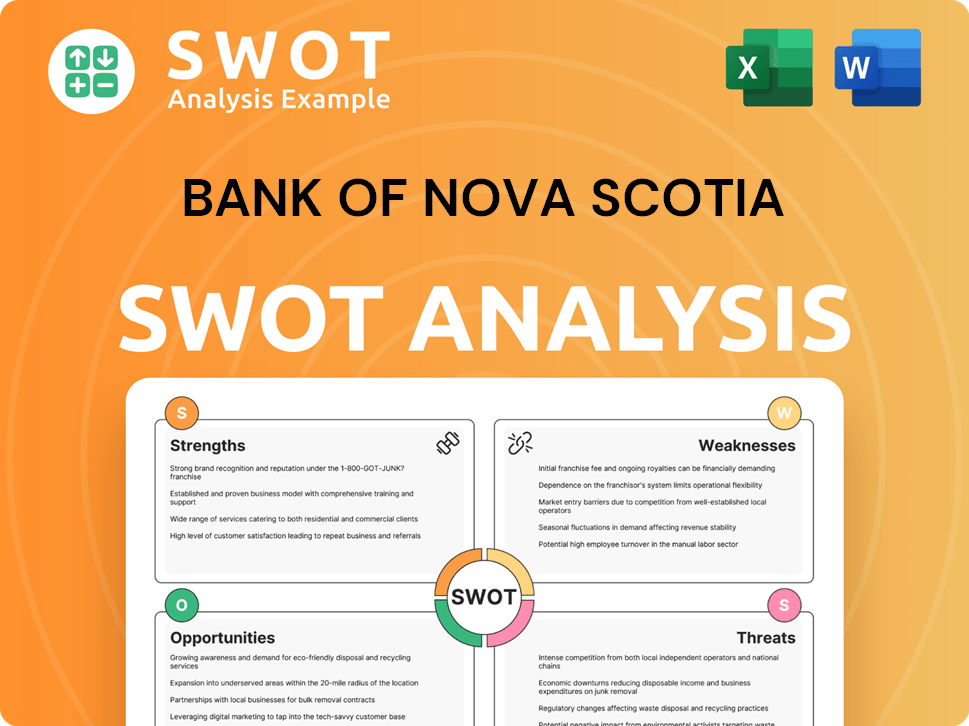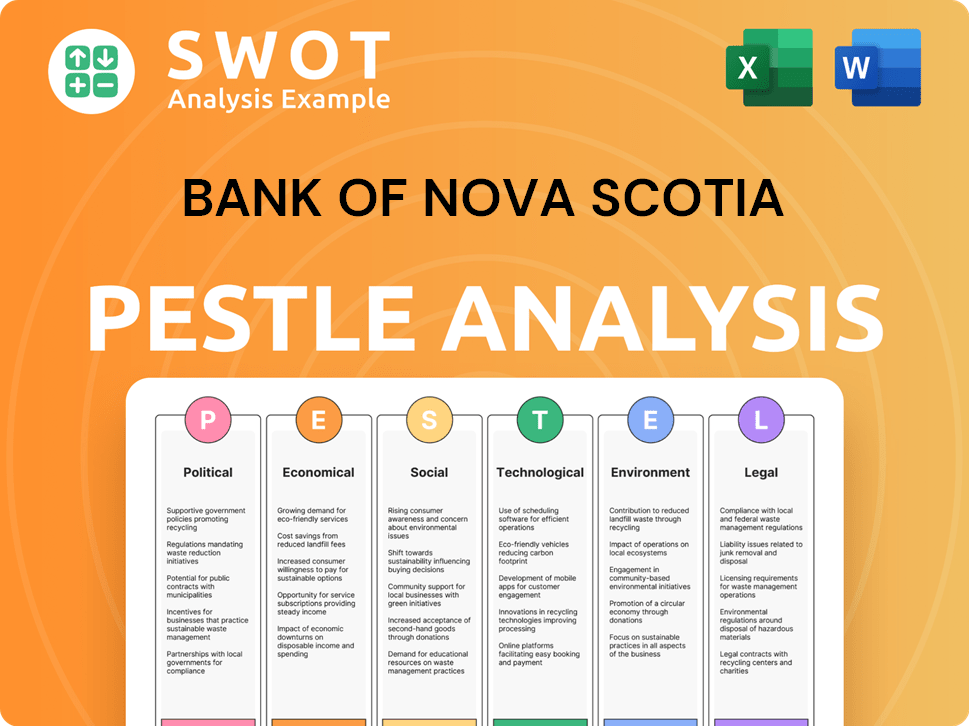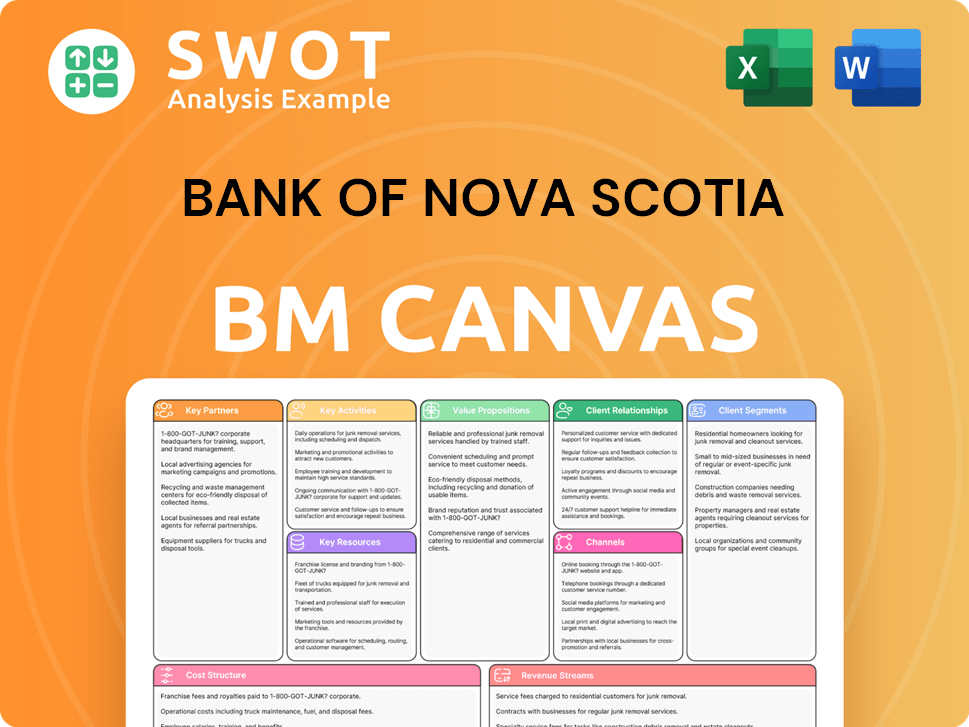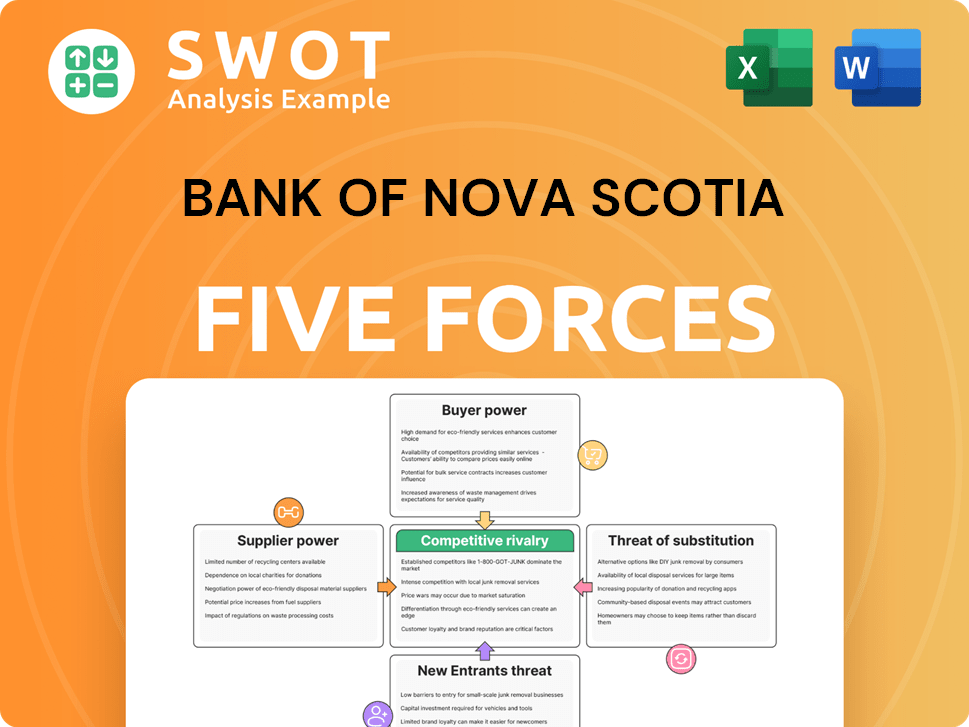Bank of Nova Scotia Bundle
How Does Bank of Nova Scotia Thrive in Today's Banking Arena?
The financial services sector is in constant flux, driven by technological advancements and evolving customer expectations. This dynamic environment demands that institutions like Scotiabank continually adapt and innovate to stay ahead. Understanding the Bank of Nova Scotia SWOT Analysis is crucial for grasping its position within this competitive landscape.

This exploration into Scotiabank's competitive landscape offers a comprehensive market analysis, examining its strategic moves and its standing within the banking industry. We'll dissect the competitive advantages of Scotiabank, pinpoint its key competitors, and assess how it navigates challenges to maintain its financial performance. This deep dive will provide valuable insights into Scotiabank's business strategy and its global presence.
Where Does Bank of Nova Scotia’ Stand in the Current Market?
Scotiabank, a major player in the financial services sector, holds a strong market position within the Canadian banking industry. As one of the 'Big Six' Canadian banks, it demonstrates significant market share and influence. Its operations span across personal and commercial banking, wealth management, and corporate and investment banking, providing a wide array of financial solutions to diverse customer segments.
The bank's value proposition lies in its comprehensive suite of financial products and services, catering to individuals, small businesses, large corporations, and high-net-worth clients. Scotiabank's focus on digital transformation enhances customer experience and operational efficiency. Its international presence, particularly in Latin America, diversifies revenue streams and strengthens its global footprint.
Scotiabank consistently ranks among the top financial institutions in Canada. While exact market share figures fluctuate, its substantial presence is evident in total assets and market capitalization. The bank's strong position is maintained across various financial segments, highlighting its competitive strength within the Canadian banking industry.
Scotiabank has a significant international footprint, especially in Latin America and the Caribbean. This geographical diversification helps to mitigate risks and capitalize on growth opportunities in emerging markets. The bank's international segment contributed a notable portion of its earnings in fiscal year 2023, showcasing its global reach.
Scotiabank's financial health is demonstrated by consistent profitability and strong capital ratios, generally aligning with or exceeding industry averages. The bank's robust financial performance supports its ability to invest in strategic initiatives and maintain a competitive edge. For instance, its total assets were reported at approximately CAD 1.4 trillion as of Q1 2024.
Scotiabank's strategic focus includes digital transformation to improve customer experience and operational efficiency. The bank also emphasizes its international operations, particularly in high-growth markets within Latin America. These strategic moves aim to diversify revenue streams and enhance its competitive position. For more information about the bank's structure, consider reading about Owners & Shareholders of Bank of Nova Scotia.
Scotiabank's competitive advantages include a strong brand reputation, a diversified business model, and a significant international presence. Its focus on digital innovation and strategic investments in high-growth markets further enhance its competitive position. The bank's financial stability and consistent performance also contribute to its ability to compete effectively in the market.
- Strong brand recognition and customer loyalty.
- Diversified revenue streams across various business segments.
- Strategic focus on digital transformation for enhanced customer experience.
- Significant presence in high-growth international markets, especially in Latin America.
Bank of Nova Scotia SWOT Analysis
- Complete SWOT Breakdown
- Fully Customizable
- Editable in Excel & Word
- Professional Formatting
- Investor-Ready Format

Who Are the Main Competitors Challenging Bank of Nova Scotia?
The Bank of Nova Scotia, also known as Scotiabank, operates within a complex competitive landscape in the financial services sector. This environment includes both direct and indirect competitors, each vying for market share in various segments. Understanding these competitors is crucial for assessing Scotiabank's market position and its strategic responses to maintain and grow its business.
Scotiabank's competitive challenges are multifaceted, ranging from established banking giants to emerging fintech companies. The bank's success depends on its ability to adapt to changing market dynamics, technological advancements, and evolving customer preferences. A thorough market analysis reveals the key players and the strategies Scotiabank employs to differentiate itself.
The banking industry is dynamic, and Scotiabank's approach to navigating this landscape is critical. For a deeper dive into the financial aspects, consider exploring Revenue Streams & Business Model of Bank of Nova Scotia.
The primary direct competitors of Scotiabank in Canada are the other 'Big Five' banks. These include Royal Bank of Canada (RBC), Toronto-Dominion Bank (TD Bank), Bank of Montreal (BMO), and Canadian Imperial Bank of Commerce (CIBC). Each bank offers a comprehensive suite of financial services, competing across various segments.
RBC is Canada's largest bank by market capitalization, often challenging Scotiabank in wealth management and capital markets. RBC's extensive global operations and diverse service offerings make it a formidable competitor. In 2024, RBC reported a net income of $15.6 billion.
TD Bank is known for its strong retail banking presence in both Canada and the U.S. It competes with Scotiabank on branch network size and customer convenience. TD's focus on digital innovation and customer experience is a key differentiator. In 2024, TD reported a net income of $11.8 billion.
BMO competes with Scotiabank across various product lines, often targeting specific client segments. BMO's strategic focus includes digital innovation and expansion in key markets. BMO's net income in 2024 was $7.4 billion.
CIBC also vies for market share, focusing on client relationships and digital offerings. CIBC's strategy includes investments in technology and personalized banking solutions. CIBC reported a net income of $6.2 billion in 2024.
Internationally, Scotiabank faces competition from large regional banks and global financial institutions, particularly in Latin America. These competitors often have established customer relationships and extensive branch networks.
In countries like Mexico, Chile, Peru, and Colombia, Scotiabank competes with local players. For instance, Grupo Financiero Banorte in Mexico and Banco de Crédito del Perú are significant competitors. These banks possess deep-rooted customer relationships and extensive branch networks.
Indirect competitors include credit unions, fintech companies, and specialized lenders. Fintechs are disrupting the traditional banking industry with digital-only services and innovative solutions.
- Fintech Companies: Digital challenger banks and payment platforms offer services at lower costs.
- Credit Unions: Provide alternative banking options.
- Specialized Lenders: Focus on niche markets.
- Mergers and Alliances: Consolidation within wealth management and partnerships between banks and tech firms reshape the competitive landscape.
Bank of Nova Scotia PESTLE Analysis
- Covers All 6 PESTLE Categories
- No Research Needed – Save Hours of Work
- Built by Experts, Trusted by Consultants
- Instant Download, Ready to Use
- 100% Editable, Fully Customizable

What Gives Bank of Nova Scotia a Competitive Edge Over Its Rivals?
The competitive landscape for the Bank of Nova Scotia (Scotiabank) is shaped by its strategic moves, key milestones, and competitive edge within the financial services sector. Scotiabank's history, marked by significant acquisitions and expansions, has solidified its position as a major player in the banking industry. The bank continually adapts its strategies to navigate a dynamic market, focusing on innovation and customer-centric solutions to maintain its competitive advantage.
Scotiabank's commitment to digital transformation and global expansion are pivotal in its competitive strategy. Recent initiatives highlight its focus on enhancing operational efficiencies and improving customer experience through digital platforms. These efforts are crucial for competing with both traditional banks and emerging fintech companies. The bank's ability to adapt to evolving customer preferences and technological advancements is critical for long-term success.
Market analysis reveals that Scotiabank's competitive position is influenced by its ability to leverage its strengths while mitigating the challenges posed by its rivals. The bank's focus on international markets, particularly in Latin America and the Caribbean, provides a diversified revenue stream and access to high-growth economies. This global presence, combined with a strong brand and diverse service offerings, contributes to its sustained competitive advantage.
Scotiabank's extensive international presence, particularly in Latin America and the Caribbean, is a key differentiator. This global reach allows the bank to access diverse markets and mitigate risks associated with over-reliance on a single region. The bank's deep understanding of local markets and regulatory environments supports its strategic expansion and operational success.
The bank's diversified business model, encompassing personal and commercial banking, wealth management, and corporate and investment banking, caters to a wide range of customer needs. This breadth of services fosters client loyalty and creates cross-selling opportunities. The ability to offer a comprehensive suite of financial products and services enhances its competitive position.
Scotiabank's investment in digital transformation and technological advancements is crucial for enhancing operational efficiencies and improving customer experience. This focus on technology helps the bank compete with agile fintech companies and meet evolving customer expectations for digital banking services. The bank's digital initiatives are designed to streamline processes and enhance customer engagement.
Scotiabank's strong brand equity, built over nearly two centuries, contributes significantly to customer trust and loyalty. This long-standing reputation provides a competitive advantage, especially in an industry where trust is paramount. The bank's commitment to customer service and financial stability reinforces its brand value and customer relationships.
Scotiabank's competitive advantages are underpinned by its global reach, diversified business model, and commitment to digital innovation. These strengths enable the bank to adapt to market changes and maintain a strong position in the competitive landscape.
- Extensive international presence, particularly in high-growth markets.
- Diversified business model with a comprehensive suite of financial services.
- Strong brand equity and a long history of customer trust.
- Significant investment in digital transformation and technological advancements.
- Economies of scale and a robust risk management framework.
Bank of Nova Scotia Business Model Canvas
- Complete 9-Block Business Model Canvas
- Effortlessly Communicate Your Business Strategy
- Investor-Ready BMC Format
- 100% Editable and Customizable
- Clear and Structured Layout

What Industry Trends Are Reshaping Bank of Nova Scotia’s Competitive Landscape?
The financial services sector is undergoing a significant transformation, impacting the Bank of Nova Scotia (Scotiabank) and its competitors. Technological advancements, regulatory changes, and evolving consumer preferences are key drivers. These trends present both challenges and opportunities, shaping the competitive landscape within the banking industry.
Scotiabank's position requires continuous adaptation to navigate these shifts. The market analysis reveals a need for strategic responses to maintain and enhance its competitive edge. Understanding the financial services landscape is crucial for informed decision-making.
Digital transformation is a major trend, with banks investing heavily in technology. Consumer demand for digital banking services is increasing. Regulatory changes and global economic shifts also influence the sector.
Increased competition from fintech companies and non-traditional financial service providers is a growing challenge. Maintaining profitability while investing in technology is crucial. Cybersecurity risks and data privacy are also significant concerns.
Leveraging technology to create new products and improve efficiency is a key opportunity. Expanding into emerging markets, especially in Latin America, presents growth potential. Strategic partnerships with fintechs can also drive innovation.
Scotiabank is focused on accelerating digital transformation and optimizing its international operations. Maintaining a strong capital position is also a priority. Customer-centricity is a key focus for future success.
To remain competitive, Scotiabank must prioritize digital transformation and customer experience. Strategic partnerships and expansion into growth markets are also vital. Adapting to regulatory changes is crucial for sustained success.
- Enhance digital banking platforms and offerings.
- Expand into high-growth markets, such as Latin America.
- Form strategic partnerships with fintech companies.
- Focus on ESG and sustainable finance initiatives.
For more insights, explore the Target Market of Bank of Nova Scotia. Scotiabank's ability to adapt to these trends will determine its future market position and competitive advantages of Scotiabank. The Bank of Nova Scotia competitors analysis shows that the bank is actively navigating the shifting competitive environment. Understanding how does Scotiabank compete is key to assessing its long-term viability. The Scotiabank business strategy includes a focus on digital transformation, international expansion, and maintaining a strong capital base. The Scotiabank market share is influenced by its ability to innovate and respond to market changes. Bank of Nova Scotia financial performance is impacted by global economic conditions and the bank's strategic initiatives. The Bank of Nova Scotia SWOT analysis reveals both strengths and areas for improvement. Recent acquisitions and strategic partnerships also play a role in its Bank of Nova Scotia global presence and competitive positioning. Scotiabank vs. other banks is a constant evaluation, with the bank striving to maintain its position within the competitive analysis of Canadian banks. Key to its success will be its ability to capitalize on opportunities and mitigate risks in the dynamic financial landscape.
Bank of Nova Scotia Porter's Five Forces Analysis
- Covers All 5 Competitive Forces in Detail
- Structured for Consultants, Students, and Founders
- 100% Editable in Microsoft Word & Excel
- Instant Digital Download – Use Immediately
- Compatible with Mac & PC – Fully Unlocked

Related Blogs
- What are Mission Vision & Core Values of Bank of Nova Scotia Company?
- What is Growth Strategy and Future Prospects of Bank of Nova Scotia Company?
- How Does Bank of Nova Scotia Company Work?
- What is Sales and Marketing Strategy of Bank of Nova Scotia Company?
- What is Brief History of Bank of Nova Scotia Company?
- Who Owns Bank of Nova Scotia Company?
- What is Customer Demographics and Target Market of Bank of Nova Scotia Company?
Disclaimer
All information, articles, and product details provided on this website are for general informational and educational purposes only. We do not claim any ownership over, nor do we intend to infringe upon, any trademarks, copyrights, logos, brand names, or other intellectual property mentioned or depicted on this site. Such intellectual property remains the property of its respective owners, and any references here are made solely for identification or informational purposes, without implying any affiliation, endorsement, or partnership.
We make no representations or warranties, express or implied, regarding the accuracy, completeness, or suitability of any content or products presented. Nothing on this website should be construed as legal, tax, investment, financial, medical, or other professional advice. In addition, no part of this site—including articles or product references—constitutes a solicitation, recommendation, endorsement, advertisement, or offer to buy or sell any securities, franchises, or other financial instruments, particularly in jurisdictions where such activity would be unlawful.
All content is of a general nature and may not address the specific circumstances of any individual or entity. It is not a substitute for professional advice or services. Any actions you take based on the information provided here are strictly at your own risk. You accept full responsibility for any decisions or outcomes arising from your use of this website and agree to release us from any liability in connection with your use of, or reliance upon, the content or products found herein.